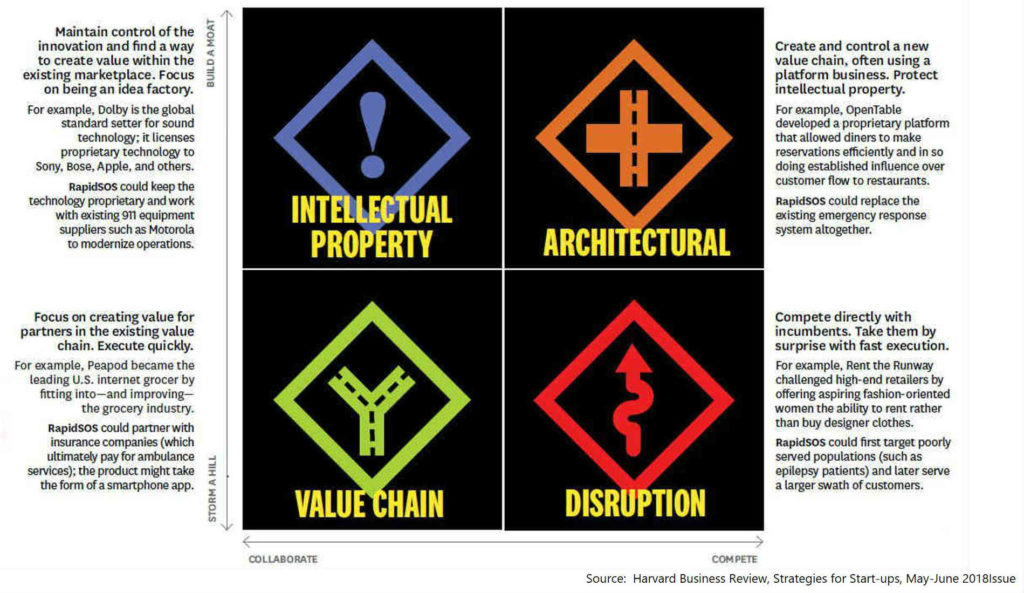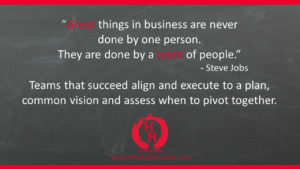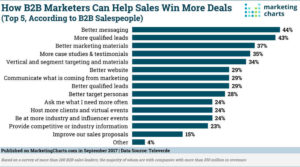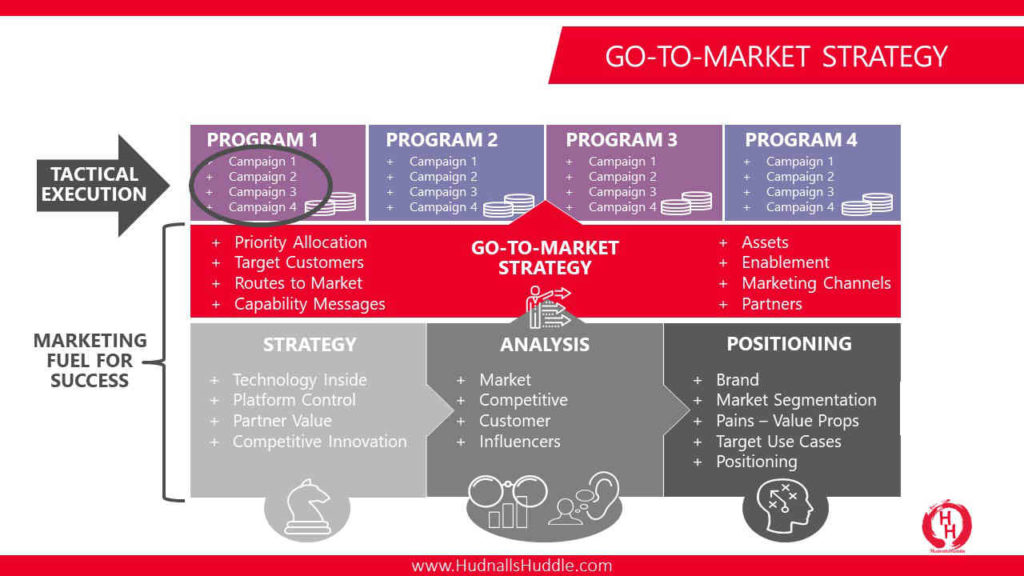S Y N O P S I S
The sales and marketing misalignment is well documented, however, it is much greater. It is the misalignment of marketing within organizations, not just with sales. The misalignment is prevalent today, as most do not see the connection between marketing and revenue. Most treat marketing as a cost and rush to execution, bypassing planning and leading to random acts of marketing. In essence, developing a message one off, over and over again. Sales is feeling the front line pains of misaligned messages and tactics, but sales is also part of the challenge in pressing for leads, more leads and now, only to later become disillusioned that they don’t lead anywhere. Then the cycle begins again. Sound familiar?
Start-up is not an excuse to bypass planning, act chaotic and spin on a whim. It is just a point in which your business is in it’s cycle. Organizations need to align to a common goal of bringing their product to market, driving revenue and various teams carry-out various functions in that process. Marketing must not be treated as merely a sunk cost.
It will take 3 things:
- Organizational alignment
- Focus on common goals
- Positioning and GTM Strategy
Give me six hours to chop down a tree, I will
spend the first four sharpening the axe.
– Abraham Lincoln
Sales, marketing and the organization are by design, misaligned. Organizations often see marketing as a cost of business and don’t make the link to revenue generation. Marketing also does not make the link to revenue for their organizations. Marketing is often measured on number of leads, not quality, while sales is measured on revenue targets. A blind eye is turned to quality. Taking the time to develop Positioning and Go-to-Market (GTM) Strategy is seen as time consuming in lieu of, we need to execute now, but the GTM strategy would bring quality and consistency of execution.
Positioning and GTM strategy are living documents and should act as a guideline to execution with the spirit of alignment and consistency. If it is not working, it’s time for the team to adjust or pivot. Dissatisfaction with the results comes down to perception of what execution means and the measurement, remember you receive what you incent and measure.
Prospects and customers are drowning in execution content that is not useful from those who just execute, slowing the decision making process and staying with the status quo. Who do they trust when they receive mixed messages from the same organization or see content that isn’t relevant in keeping up with shifting customer objectives? Sales teams are burnt out following up on the volume of leads that lead no where.
Positioning, GTM strategy, sales and organizational alignment, or lack there of, are the hot topics of the month with CMO surveys and various articles that this post draws analysis from.
Increasingly, CMOs and their teams are being tasked with leading transformation and growth efforts, which won’t be successful if they aren’t able to align strategy and direction with the rest of the C-Suite to harness the full power of the entire organization, said Caren Fleit.
– Source: Korn Ferry, CMO Pulse Survey 2018
CHALLENGES
The latest release of The CMO Survey is just under a hundred pages of metrics. I honed in on the spend regarding digital and social media to further illustrate that tactical activity is keeping sales and marketing teams from aligning and focusing on common revenue targets.
 The first metric tells me that marketing organizations are mired down in the stress of “just executing” digitally without a plan taking attention off of strategic initiatives. The plan is to grow the spend over the next 5 years to be 20%+ of the marketing budget, however in lieu of a strategy, 45%+ stated targeting awareness building. 18% of the activity is performed by outside agencies (i.e., expensive), further exacerbating the spend on “just executing”.
The first metric tells me that marketing organizations are mired down in the stress of “just executing” digitally without a plan taking attention off of strategic initiatives. The plan is to grow the spend over the next 5 years to be 20%+ of the marketing budget, however in lieu of a strategy, 45%+ stated targeting awareness building. 18% of the activity is performed by outside agencies (i.e., expensive), further exacerbating the spend on “just executing”.
On a scale of 1 – 7, marketers indicated that the degree of the use of social media on company performance ranks about a 3 and yet the spend will double over the next 5 years.
How do you justify doubling the spend on something you cannot tie to company performance or positive results?
Finally, I attribute much of the “just execute” and focus on digital tactics to the exponential growth of tools in the MarTech market as illustrated in the Chief Martec.com Marketing Technology Landscape:
Martec.com Marketing Technology Landscape:
- 2011 – 2018 – Tools grew from 150 to almost 7,000 tools – 4,567% growth
- 2011 – 2018 – Market Revenue grew from $6B – $14B – 133% growth
- 2017 – 2018 – Rate of churn is 4.5% – almost non-existent churn
- Doesn’t this chart have you asking yourself, “Who has the job of putting ~7,000 unique logos into a graphic?” Mind boggling.
This screams of the old adage, “A fool with a tool is still a fool”.
Shouting at the market and drowning the market with irrelevant content will not attain revenue targets, gain awareness, speed closing opportunities and moves organizations further away from defining and executing a strategy that becomes a “revenue engine”.
ORGANIZATIONAL ALIGNMENT
The Korn Ferry: CMO Pulse Survey 2018 summarizes well the state of the CMO and marketing, highlighting the misalignment of marketing within the organization. While almost half of the CMO’s who participated in survey state that their bonus is tied to financial performance, yet half of them cannot tie their efforts to company performance. In these organizations I would say the role of marketing is not understood and is treated as a cost of business.
The Survey also highlights that about a third of CEO’s don’t understand the role of the CMO and the connection between marketing and revenue generation. Just as the CEO does not care to understand the details of how to build the product, miring them down in the details of how marketing operates only adds to the myth of a big, hard and ugly challenge. This is where measuring marketing influence against opportunities and targeted revenue attainment would lead to a better discussion.
The survey quotes the MKTGinsight: Stop Rushing Past Strategy to Get to Execution article (4-26-18 by Tim Steele) with a Hubspot metric indicating that organizations cite >60% of their marketing challenges are in generating traffic and leads. This is a focus on measuring activity with only 40% able to prove an ROI on efforts based on activity over revenue impact. 
60% are unable to produce effective ROI’s on their activities. This indicates to me that these are activities treated as a cost to the business and not of value.
The positive news from the survey and my own experiences, is that organizations are turning to marketing to lead transformation of growth. In order to take on the challenge of transformation, the organization must shift from treating marketing as a cost and understand the value marketing can provide. The CMO and marketing organization must gain support from the organization to attain success in the transformation, it will take time. Marketing will need to execute tactically in the short term, while planning strategically long term.
FOCUS ON COMMON REVENUE GOALS
The friction between sales and marketing is well documented and a vicious cycle of generating leads, follow up, frustration, leading to we need a better message and the cycle begins again. On one hand, marketing claims success for generating leads, but if they do not lead to revenue, the organization does not grow. How is that success?
Sales is driven by one metric, revenue targets, however, marketing is measured on the number of leads and activities. This does not often translate into a common partnership, focus and plan. Sales teams have a sense of urgency and need to execute today putting marketing teams under pressure to execute tactically. The tactical execution consumes marketing resources such that positioning and GTM strategy that would lead to targeted, personalized, current content fall off the table. This creates the vicious cycle of random acts of marketing and sales friction.
Balance begins with common goals, creating a short term tactical plan (within the zip code), while planning strategically. Both teams must be focused on the same revenue attainment goals and how to get there together. I also agree with Tim Steele’s commentary in the MKTGinsight article to replace “leads gen” with “revenue engine”. I would then change the measurements to track marketing influenced opportunities to understand which tactics and content are successful.
Early in my career I was mentored by outstanding sales leaders who understood the friction within both organizations that led to 2 things I keep in mind when interacting with sales teams:
- Marketers must understand the pressures sales faces from front line customers when making what seems to be unreasonable requests.
- Marketers need to understand that when things are broken, sales will begin to invent their own marketing materials and direction to meet their target.
Sales teams I’ve worked with welcome the opportunity to not be in the inventing business and have their marketers take the lead. Often times the content and tactic pressures are driven by customers and the groups must develop the right plan together.
POSITIONING AND GO-TO-MARKET STRATEGY
Strategy, so what and what are we talking about? This is the heart, soul and fuel to your success. “Measure Twice – Cut Once”. The digital tools available today provide the ability for anyone to call themselves a marketer or better said, shout from a street corner. Someone may turn their head, but engagement happens when you plan the follow through, provide content worth coming back to and the continuous engagement, otherwise it is nothing more than noise.
The consumer market now has B2B buyers expecting personalization and messages that speak to them directly, illustrating authenticity, trust and partnership building. This requires consistent and continuous content that is relevant to revisit and is the definition of Content Marketing, as opposed to Marketing Content. This begins to address the quantity over quality challenge with leads and the uprising of Account Based Marketing (ABM – a post for another day). Focused targeting and personalization is exactly why upfront segmentation and positioning are important to developing and executing quality, authentic campaigns.
Harvard Business Review ran a series of articles in the May – June 2018 edition, Do Entrepreneurs Need a Strategy?, that defines a framework and also debates the other side of the coin, why do you need a strategy. While it is exciting to “fly by the seat of your pants” and those high flying tech companies garner huge attention – fewer than 3% succeed. This metric is stated in the counter article to the need for a strategy article.
I take the middle road. The Strategy Phase and plan garner success for organizational alignment, market consistency, trust and authenticity building and forward trajectory.
This chart represents part of a Market Requirements Document (MRD). It defines the market the product is targeting and your strategy in going to market. This article describes the four approaches quite well and I will only summarize by saying that each of these strategies have very different routes to market and thus marketing strategies.
While some products can be many things, taking a hard look at where you can capitalize in the market with focus and expanding into other markets leads to greater rewards, rather than throwing the proverbial bowl of spaghetti at the wall waiting for something to stick. One point I want to call out from the article is defining your Intellectual Property (IP) as a differentiation. IP is not a differentiator unless customers see value in what it delivers. What it delivers is the value and those who define IP as their differentiation, tell me that they are engineering led, not customer driven, do not understand customer pains and value.
The second chart from the article represents brand strategy and positioning, the Analysis Phase. Once you define your strategy to approach your market, now you need to define who your customers are, what the technology is and does for them, your brand and why you and finally how you differentiate from the competition.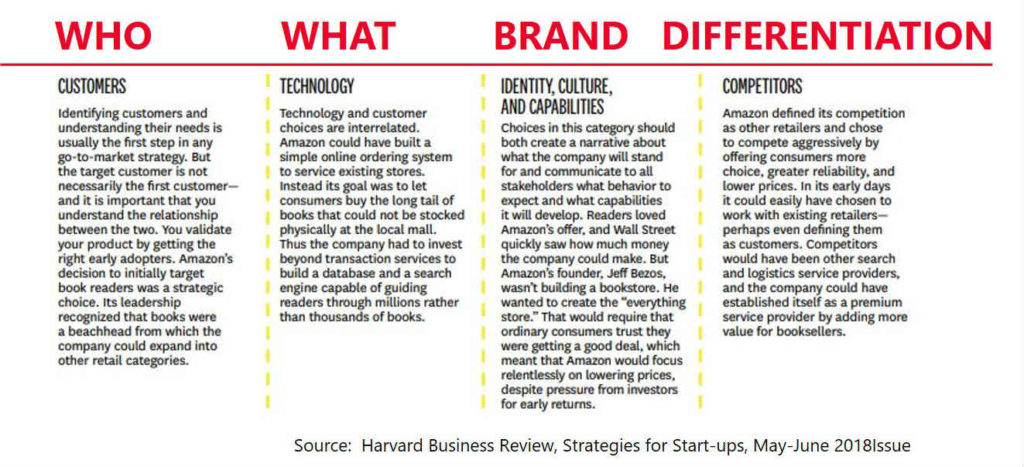
Once you define each of these, you have focus and can define the themes to go to market and value propositions for each of those themes, the Positioning Phase. You can group and represent 3-5 major themes based on current market challenges / value, but you may only choose to market a couple of them as those are where you expect to drive revenue in current market conditions.
It is also worth stating that your brand message and value is not the same as your GTM themes. Brand is who you are and how you want customers to feel and act regarding you as a provider. GTM themes sit under the umbrella of the brand and address customer pain and value requirements. While building out extreme personalization of themes is not possible, building out common themes and using them as play cards to be mix and matched based upon the opportunity should be the goal.
LET’S WRAP THIS UP
I’m not suggesting turning this into a 3 year science project of perfection, but rather building enough of a guideline that you revisit annually to begin focusing on a strategy and formulating GTM market positioning and plans to align to as an organization. If something is not working, work as a team to assess. Does it require a tweak to the marketing message or does it require a pivot in strategy?
This chart represents a good summary of the symptoms that surface when there isn’t a strategy in place and the goals are misaligned. As a former market influencer, I can also tell you that suppliers that lack organizational alignment and strategy are easy to spot in the landscape, as well.
TALES FROM THE TRENCHES
I’ve worked with many teams where I have watched magic happen when the team and organization align and execute a strategy, messages, campaigns and opportunities with flawless consistency, as well as just the opposite. Here are a few of my most memorable experiences:
ORGANIZATIONAL ALIGNMENT
I created a problem one evening, a rather severe problem for an account early in my career. The company I worked for at the time was relentless with it’s one team culture and never finger pointing. We as a company made a mistake and we as a company will restore service and we will also do this as a team. I arrived for my shift following the restoration of service the next day and only those onsite knew who worked the shift creating the service outage. Others who were remote did not know who created the error, while working to restore service and maintain trust with the customer.
Customers do not care that you made an error, they care about what you do to correct the error and avoid making the same mistake twice.
This was a powerful and differentiating trait for this organization – unwavering alignment.
INCONSISTENT, ROGUE MESSAGING
After having had several meetings with with a very large service provider (individual meetings with myself and later with the Director of Product Management) where consistent messages of value and solution were discussed, a call was set for a demo with a technician. During the first 30 minutes of the call, the customer listened to how we build from the ground up, never getting to the value propositions previously discussed.
A break was taken to ask for feedback and the quote that has never left me from the prospect was,
WOW, what does it take to swallow that elephant?
Not what the sales executive wanted to hear and to add insult to injury, the request was made to meet requirements for functionality that our solution was superior at delivering, but our competition had discussed and provided examples for them already.
We were beat due to inconsistent messages, lack of alignment and not focusing on the customer.
MISMATCHED GOALS – QUANTITY OF LEADS VERSUS CUSTOMER GROWTH
I was in a leadership meeting when a very excited sales leader announced that we had 1500+ registrants signed up for a webinar. This made me cringe because I know the selling side of the house just heard “large number of hot prospects” and I knew it meant quantity of contacts listening to an educational, technical webinar.
This is a good illustration of what it means to measure leads versus marketing influence on opportunities. This event had a 60%+ conversion rate (900+), again, sounds great regarding attendance and meets marketing goals and was targeted as “awareness building” of new capabilities, which translates to educational, “no follow up“ planned. Marketing met the goal it was measured on, but I was not satisfied with the outcome as I knew sales would not be satisfied either.
After the event, we began “segmenting”: eliminating customers of this solution, eliminating current opportunities in flight and “targeting buyer” titles, further eliminating those who were there for educational purposes. This took us to a manageable 200+ to follow up with, but these buyers were a little less than enthusiastic as the technical “content” did not speak to them.
Now you understand why I cringed in a leadership meeting when a grand number of attendees was announced without context and misaligned content, measurements and expectations. Fortunately, we had a good relationship with the inside sales team and we worked to make lemonade from lemons.
In this case, an A for effort and a C- in execution and success. Segmentation, targeting, content and strategy have greater impact up front in delivering a higher grade for execution and success. This was working hard, not smart.
INTEGRATED STRATEGY – COMMON REVENUE GOAL
As the marketer on a team preparing for a very large and important event, we as a team worked to deliver an industry specific message, demo and integrated event focused on the customer, their pains and in their vernacular. We also did not bring the first piece of collateral. Instead, we took videos of the story to leverage on a web page after the event for those who did not attend. I was very proud of how the team aligned to contribute to the event from marketing, sales and engineering.
RESULTS: A multi-million dollar opportunity and new customer just after the show and just less than a dozen more in-person meetings leading to further revenue and customer growth. The team was authentic, built trust and spoke the language of the customer, but most of all were consistent in the delivery of the brand, message and strategy proving also that collateral is not required to close a deal.
TAKE AWAYS
The following chart illustrates where execution sits in the strategy stack and why the previous chart of, How B2B Marketers Could Help Sales Win More Deals, are symptoms of lacking strategy.
- Sales always needing better messaging, materials and website
- Sales requesting better targeted prospects and industries
- Sales wanting more leads and better leads
- Sales wanting to know what is coming from marketing
- Sales wanting competitive and industry information
As illustrated in the previous, Tales from the Trenches: Mismatched Goals, you understand what happens when you start with the tactical execution (circle below) and leave out the planning fuel and alignment (bottom 2/3rds of the chart below).
The chart below summarizes the building blocks and fuel that works to better deliver success in target attainment.
When the organization drives marketing to deliver leads and measures only activity, while sales is measured on revenue, friction will continue. The GTM strategy is the fuel for success and as my father always said:
Short cuts never got anyone anywhere fast!
The above illustrates the path to success:
- Align organizationally
- Align sales and marketing to common revenue performance goals
- Strategy matters – quality over quantity/targeted; personalization/ABM
- Remember the strategy is a guideline – reassess, tweak and pivot as a team
One of the first meetings I request within organizations with which I work is with the sales team. I want to align efforts to supporting the revenue, even if the organization is measuring tactics. I will say in most cases, you will not be faulted for supporting the drive to revenue growth.
* * * * *
Now I ask you: How will your organization align for your Go-to-Market activities?
Share your comments below or connect with me!
A related post:
Sources used for the analysis and statistics:
Korn Ferry – CMO Pulse Survey 2018
The CMO Survey – The CMO Survey Highlights and Insights Report February 2017
MKTGisights – Marketing Strategy vs Execution
ChiefMarTec – Marketing Technology Landscape
Harvard Business Review – Do Entrepreneurs Need a Strategy?
Marketing Charts – How B2B Salespeople Feel Marketing Can Help Them Win More Deals
Photo credits: Pixabay, Grand Canyon Under Black Sky with Lightning During Daytime 144244, (CC0)




